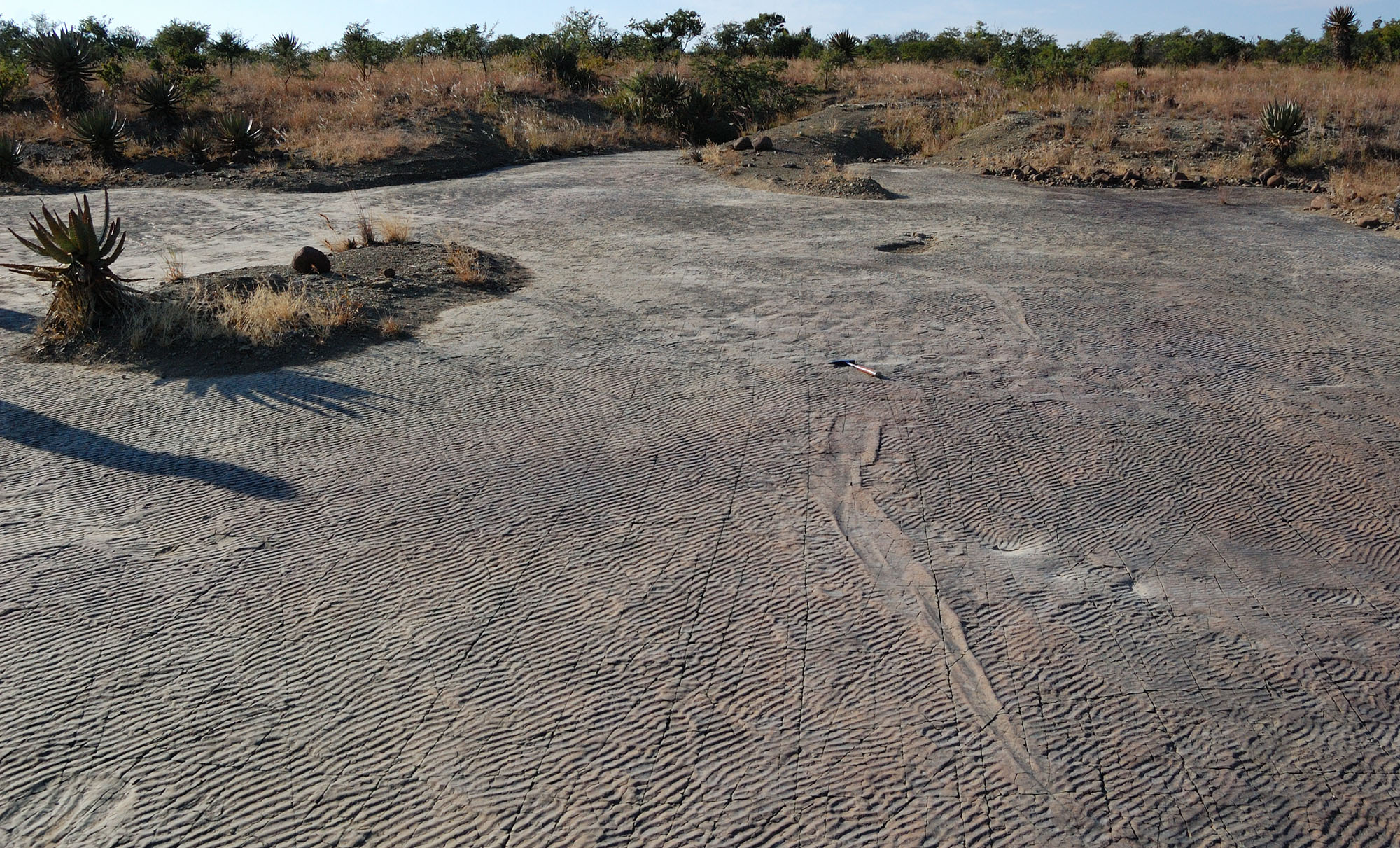The impressions are believed to have been left by the tail and body of a squat 2m-long amphibian that, 250 million years ago, was swimming in the shallow sea that covered most of what is now South Africa.
In a paper that appeared in the open-access journal PLOS One on 29 March, scientists provided evidence that the fossilised imprints found on a rock surface on a farm near Estcourt in KwaZulu-Natal were left by Rhinesuchid temnospondyls, a large predatory amphibian.
“That’s the first time this sort of swimming behaviour has been recorded for a Rhinesuchid temnospondyls amphibian,” explains one of the authors of the paper, Bruce Rubidge, a professor at the Evolutionary Studies Institute, University of the Witwatersrand.
To reach this conclusion, the researchers had to become trackers reading and interpreting the spoor left by a creature that lived a quarter of a billion years ago.
 A comparison of the trace fossils with a present-day body impression and trail of Alligator mississippiensis on the foreshore at St Catherines Island in Georgia, US. (Image: Supplied)
A comparison of the trace fossils with a present-day body impression and trail of Alligator mississippiensis on the foreshore at St Catherines Island in Georgia, US. (Image: Supplied)
For the lead author of the paper, Dr David Groenewald, it meant having to trawl through research papers and examine photographs of impressions left by modern-day crocodiles and salamanders to see if he could get a match.
Groenewald got his Eureka moment.
He found identical marks left by crocodiles on the bottom of waterways. He was able to deduce that the marks were left by the tail of the prehistoric predator as it propelled itself from the bottom into the water column. The lack of fossilised footprints with some of the impressions suggests that the animal was swimming with its legs tucked along the side of its body, similar to how crocodiles swim today.
“It is one of those sites that every time I went back there was something that I hadn’t seen before,” says Groenewald.
Unlike the usual bone fossils, these prehistoric impressions captured the animal in motion.
Read more in Daily Maverick: Remains of prehistoric 3-metre fish discovered in Eastern Cape
It has been revealed that these prehistoric amphibians led an active lifestyle of swimming and bottom walking.
How these prints survived the weathering of millions of years as continents broke up and ice ages came and went probably had to do with a mat of algae that quickly grew over the impressions.
“Basically, what that algal film did was consolidate the sediment, making it a little bit more resistant to weathering,” says Groenewald. “Then it would have been covered over by more mud.” Millions of years of weathering would have then exposed the fossils.
These prehistoric impressions are known as trace fossils and over the last couple of decades, they have been providing palaeontologists with insight into the behaviour of long-dead species. The best-known trace fossils are footprints. The study of dinosaur footprints has allowed scientists to work out whether some animals lived in herds.
More recent human footprints that date back to the last Ice Age are allowing palaeoanthropologists a glimpse into the lives of our Stone Age ancestors.
“So [trace fossils] are becoming an important part of the fossil heritage. Probably 20 years ago, there were probably five known trackways from across South Africa. Now we have many more from different ages,” Rubidge says.
 A Krüger aerial shot of Impression 2 and 3 separated by a 'corridor' of fossil footprints. (Photo: Supplied)
A Krüger aerial shot of Impression 2 and 3 separated by a 'corridor' of fossil footprints. (Photo: Supplied)
Rubidge was first made aware of the Estcourt trace fossils about two decades ago when the farmer David Green got hold of him.
Green was an avid fossil collector and suspected that the impressions on the rock surface were trace fossils. Later, Groenewald was given the task of working out what the trace fossils were, as part of an honours project at Wits University.
Read more in Daily Maverick: From coelacanths to crinoids: these 9 ‘living fossils’ haven’t changed in millions of years
Besides the amphibian impressions, there are also traces of fish that point to the spot once being the shoreline of the Ecca sea. At the time, the Ecca or the Karoo sea, as it is known, was believed to be receding.
“This almost records the last tide going out of the Karoo sea,” says Rubidge.
Green never got to find out what left those strange marks cut into the rock. He was murdered on his farm in 2007. The rock surface has since been named the Dave Green palaeosurface in his honour.
“I’m sorry that Dave wasn’t around to see this paper published. He would have been intrigued by it,” says Rubidge.
Tracking the spoor of animals long gone promises to flesh out more of that story of our distant past.
“There are a lot more of these trackways out there, some that we are aware of, others that have yet to be discovered. There is a hell of a lot more to learn about the behaviour of these animals and there is a lot to be revealed,” says Dr Mike Day of the Natural History Museum in London and an author of the paper. DM/OBP




 A Krüger aerial shot of Impression 2 and 3 separated by 'corridor' of fossil footprints. (Photo: Supplied)
A Krüger aerial shot of Impression 2 and 3 separated by 'corridor' of fossil footprints. (Photo: Supplied)